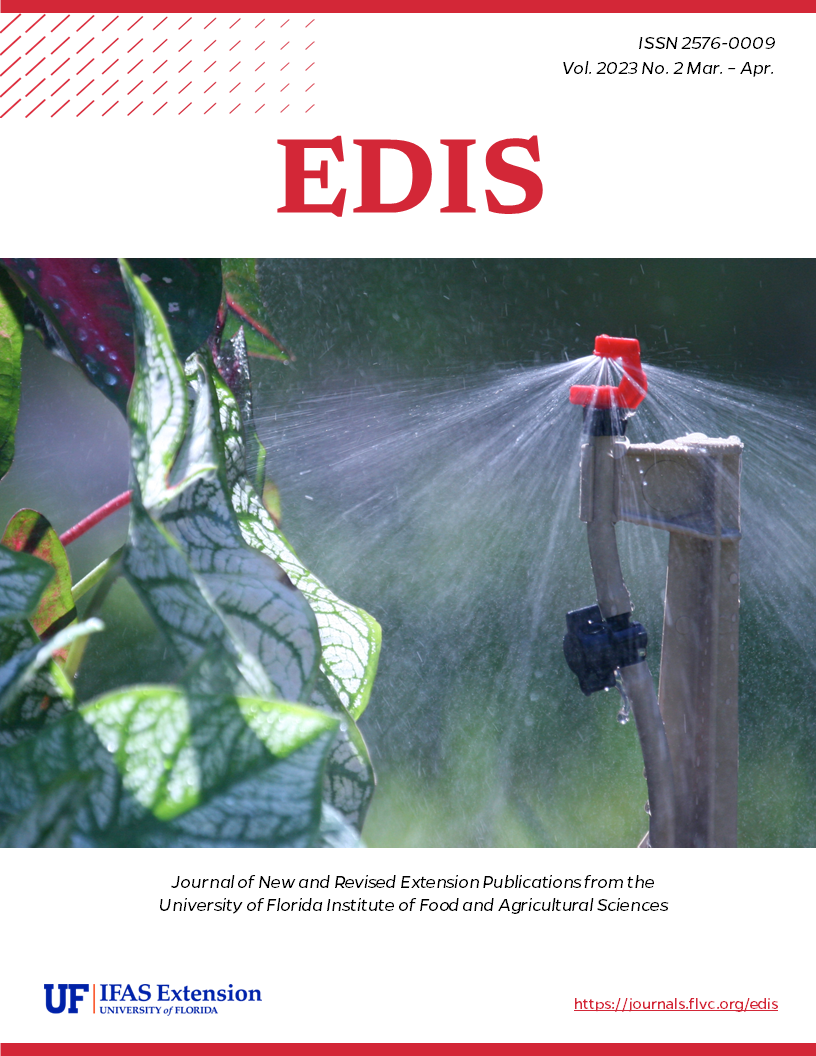Abstract
Neohydronomus affinis Hustache is known as the waterlettuce weevil (Figure 1). It is a biological control agent of the floating plant, waterlettuce, Pistia stratiotes Linnaeus (Araceae) (O’Brien & Wibmer, 1989; Center et al., 2002). Waterlettuce is found in tropical and subtropical regions of the world. It infests slow-moving streams, waterways, lakes, and rivers, forming dense floating mats that are composed of several rosettes connected by stolons (runner stems). The presence of waterlettuce mats diminishes biological diversity and generates obstructions for boating, waterflow, and aquatic organisms (Cordo & Sosa, 2000; Dray & Center, 2002). Even though waterlettuce was documented by explorer William Bartram in Florida before 1765 (plants-archive.ifas.ufl/plant-directory), it is listed as a class II prohibited aquatic plant in the State of Florida.
There are three species in the genus Neohydronmus, all of which originate from South and Central America. These weevils are subaquatic, and their exoskeletons are covered in white scales with no water-resistant features. The three species are all associated with waterlettuce and feed exclusively on it (Center et al., 2002; O’Brien & Wibmer, 1989). Among them, N. affinis was first introduced as a biological control agent into Florida in 1987 at Torry Island and Kreamer Island at the south end of Lake Okeechobee (Dray et al., 1990; 2001). Since then, the insect has successfully established itself in peninsular Florida and is also reported in Louisiana (Center et al., 2002).
References
Adebayo AA, Briski E, Kalaci O, Hernandez M, Ghabooli S, Beric B, Chan F, Zhan A, Fifield E. 2011. Water hyacinth (Eichhornia crassipes) and water lettuce (Pistia stratiotes) in the Great Lakes: Playing with fire? Aquatic Invasions, 6(1), 91. https://doi.org/10.3391/ai.2011.6.1.11
Center T, Dray F, Jubinsky G, Grodowitz M. 2002. Insects and other arthropods that feed on aquatic and wetland plants. United States Department of Agriculture. Agricultural Research Service, Technical Bulletin.
Cilliers CJ. 1987. First attempt at and early results on the biological control of Pistia stratiotes L. in South Africa. Koedoe, 30(1), 35-40. https://doi.org/10.4102/koedoe.v30i1.500
Cordo HA, Sosa A. 2000. The Weevils Argentinorhynchus breyeri, A. bruchi and A. squamosus (Coleoptera: Curculionidae), Candidates for the Biological Control of Waterlettuce (Pistia stratiotes). In Proceedings of the X International Conference on Biological Control of Weeds, 4-14.
DeLoach CJ, DeLoach AD, Cordo HA. 1976. Neohydronomus pulchellus 1, a Weevil Attacking Pistia stratiotes in South America: Biology and Host Specificity 2, 3. Annals of the Entomological Society of America, 69(5), 830-834. https://doi.org/10.1093/aesa/69.5.830
Dray FA, Center T. 2002. Water lettuce. Biological Control of Invasive Plants in the Eastern United States; Driesche, RV; Blossey, B, 65-78.
Dray FA, Center TD. 1992. Biological control of Pistia stratiotes L. (waterlettuce) using Neohydronomus affinis Hustache (Coleoptera: Curculionidae). Aquatic Weed Research Laboratory US Department of Agriculture, Agriculture Research Service Fort Lauderdale, Florida.
Dray FA, Center, TD, Habeck DH, Thompson CR, Cofrancesco AF, Balciunas JK. 1990. Release and Establishment in the Southeastern United States of Neohydronomus affinis (Coleoptera: Curculionidae), an Herbivore of Waterlettuce. Environmental Entomology, 19(3), 799-802. https://doi.org/10.1093/ee/19.3.799
Dray FA, Center TD, Wheeler GS. 2001. Lessons from Unsuccessful Attempts to Establish Spodoptera pectinicornis (Lepidoptera: Noctuidae), a Biological Control Agent of Waterlettuce. Biocontrol Science and Technology, 11(3), 301-316. https://doi.org/10.1080/09583150120055718
Harley K, Forno I, Kassulke R, Sands D. 1984. Biological control of water lettuce. Journal of Aquatic Plant Management 22: 101-102.
Harley K, Kassulke R, Sands D, Day M. 1990. Biological control of water lettuce, Pistia stratiotes [Araceae] by Neohydronomus affinis [Coleoptera: Curculionidae]. Entomophaga, 35(3), 363-374. https://doi.org/10.1007/BF02375260
Holm LG, Plucknett DL, Pancho JV, Herberger JP. 1977. The world's worst weeds. Distribution and biology. University press of Hawaii.
Moore GR, Hill MP. 2012. A Quantitative Post-Release Evaluation of Biological Control of Water Lettuce, Pistia Stratiotes L. (Araceae) by the Weevil Neohydronomus Affinis Hustache (Coleoptera: Curculionidae) at Cape Recife Nature Reserve, Eastern Cape Province, South Africa. African Entomology, 20(2), 380-385. https://doi.org/10.4001/003.020.0217
O'Brien CW, Wibmer GJ. 1989. Revision of the Neotropical Genus Neohydronomus Hustache (Coleoptera: Curculionidae). The Coleopterists Bulletin, 43(3), 291-304. https://doi.org/10.1093/aesa/82.3.267
Winston RL, Schwarzländer M, Hinz HL, Day MD, Cock MJ, Julien MH. 2014. Biological control of weeds. A World Catalogue of Agents and Their Target Weeds (Fifth Edition). USDA Forest Service, Forest Health Technology Enterprise Team, Morgantown, West Virginia.
Spinner S. 2022. February 22. LSU AgCenter. Retrieved from lsuagcenter: https://www.lsuagcenter.com/topics/environment/invasive%20species/water-lettuce/biological-control.
UFIFAS. https://plants-archive.ifas.ufl.edu/plant-directory/pistia-stratiotes/

